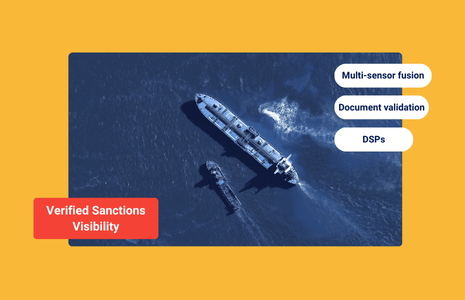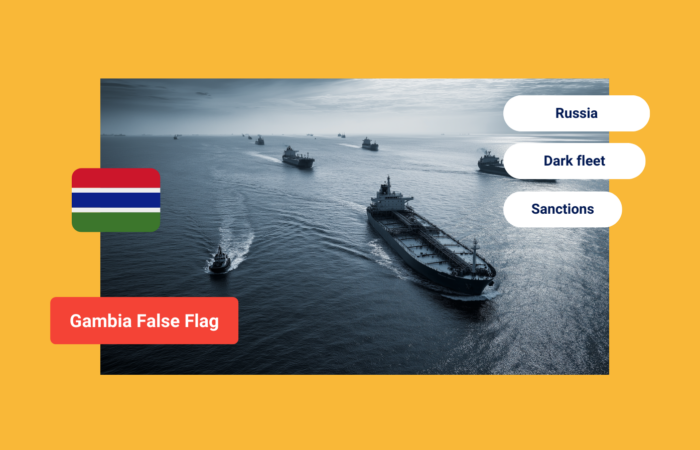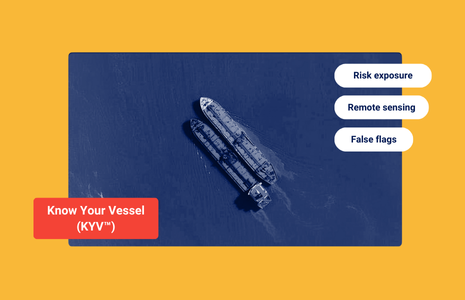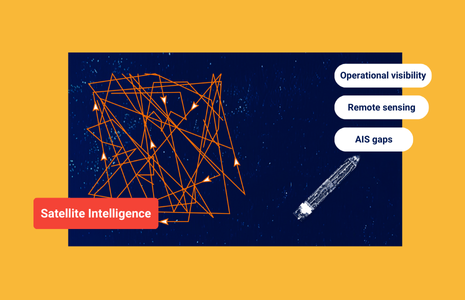Unpacking the 11th Sanctions Package Imposed on Russia…
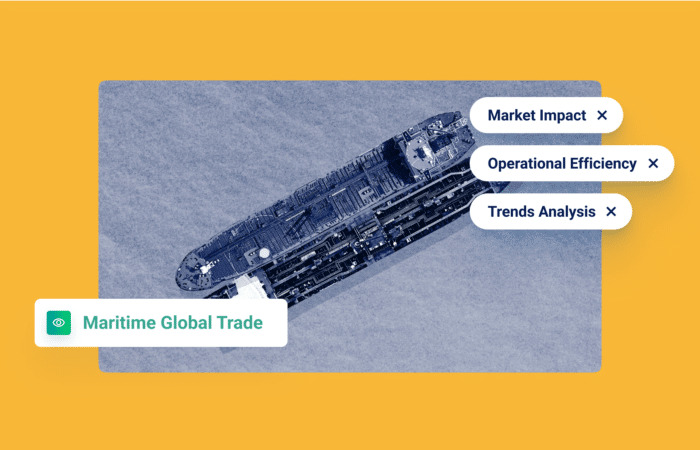
What’s inside?
Following weeks of robust discussions and negotiations, EU countries finalized the 11th sanctions package levied against Russia that is dramatically impacting global ocean trade for dry and wet bulk, and/or containerized goods.
How will this affect your organization? How should you ensure compliance? This blog post has you covered with proprietary insights from our Maritime AI™ platform that quantify deceptive shipping practices (DSPs) related to Russia and just may surprise you. It also includes actionable steps for fast compliance.
What’s Past is Prologue
The Western powers moved quickly to put a price cap on Russian oil after the outbreak of war. This resulted in a maximum price of $60 per barrel for Russian crude oil, followed by a price cap on Russian oil products. Illicit actors adopted deceptive tactics to bypass the price cap on oil, and conceal the origin of the oil, grains and other smuggled/sanctioned commodities, resulting in a big challenge for regulators.
The most widely used deceptive practices were investigated in Windward’s comprehensive report for the one-year anniversary of the war. It offered statistics on the increase in dark activity, spotlighted new hubs for smuggling Russian oil, and explained where Russian oil was headed (China, India, and South Korea, mainly).
Another result of the regulation loopholes was the emergence of “the gray and dark fleets,” used for smuggling Russian cargo while appearing to be legitimate, or at least trying to evade detection. Later, the U.S. Office of Foreign Assets Control (OFAC) expanded sanctions to include metals/mining, and grain smuggling. This was the first time sanctions went beyond oil, which was a significant change for dry bulk stakeholders.
Unpacking the Package
The EU’s 11th sanctions package went into effect on June 24, 2023. Unsurprisingly, part of the motivation was the sharp rise in DSPs:
“Attempts to circumvent Union restrictive measures have resulted in a sharp increase of deceptive practices by vessels transporting Russian crude oil and petroleum products,” the text of the Council decision reads.
Ship-to-ship (STS) transfers, location (GNSS) manipulation, and dark activity are the main behavioral targets, as noted in the Transport Measures section of the package:
- “Prohibition to access EU ports for vessels that engage in ship-to-ship transfers suspected to be in breach of the Russian oil import ban or G7 Coalition price cap.
- Prohibition to access EU ports for vessels if a vessel does not notify the competent authority at least 48 hours in advance about a ship-to-ship transfer occurring within the Exclusive Economic Zone of a Member State or within 12 nautical miles from the baseline of that Member State’s coast.
- Prohibition to access EU ports for vessels which manipulate or turn off their navigation tracking system when transporting Russian oil subject to the oil import ban or G7 price cap.”
A month’s grace period was given for the provisions on access to ports and locks for vessels engaged in ship-to-ship transfers and for vessels that interfere with their shipborne AIS when transporting Russian crude oil and petroleum products. These provisions go into effect on July 24.
In less than a month, port authorities, traders, shipping companies, and even bunker suppliers will be expected to go FAR beyond mere sanctions list screening. They’ll need automated alerts for all mentioned deceptive shipping practices, with full visibility and detection capabilities for every milestone of a vessel’s journey. Failure to keep up could lead to major sanctions breaches, reputational harm, as well as other penalties.

Containerized Goods Space is Affected
The 11th sanctions package also draws upon additional sectors from the containerized goods space that weren’t directly affected. There are approximately 800 million TEUs shipped around the world per year. Entities that are seemingly unrelated to these sanctions, such as importers and exporters, are now concerned.
They lack visibility into sanctions compliance risk that might evolve through the shipping journey and end-to-end voyage, including planned and ad-hoc transshipments. To protect themselves from risk exposure and financial harm, they will have to create new vessel tracking and monitoring processes to know whether vessels carrying their containers have planned stops at a Russian port, or will pass through the Russian EEZ and territorial waters during their voyage.
The Questions You Need to Ask Yourself
Organizations from across the shipping industry must ensure that they possess the necessary data and insights, as opposed to waiting and relying on someone else. The ability to quickly share information with allies and integrate it into their work flows will also be important.
Will your organization be able to determine which vessels entered Russia’s EEZ prior to approaching your port?
Will your organization be able to detect Russia-related STS engagements, dark activities and location (GNSS) manipulations?
Is your organization able to quickly and easily share information?
If you answered “no” to those questions, it’s time for a quick technology upgrade.
Russia-Related DSPs in European Ports by the #s
Since the beginning of the war, there have been nearly 90,000 port calls in European ports. Approximately 14% of these port calls were made by Russian-affiliated crude oil and oil products tankers – around 1,000 vessels.
Following the first price cap on crude oil trade, that number dropped to 11%, and after the oil products price cap was added, it decreased to 10%. The ban is causing a reduction, as intended, but not completely preventing oil smuggling. The risk still exists for shipping stakeholders and port authorities.
STS
The number of ship-to-ship (STS) operations between a vessel coming from Russia and a vessel going to Europe has been decreasing since the war began, especially since the introduction of the price cap. The monthly average of such operations before the price cap was 15, but it dropped to 7 post-price cap.
Dark Activities and Location (GNSS) Manipulation
During the past two years, there were over 30,000 dark activities related to sanctions evasion. More than 7,500 of those were related to the Russian regime.
From a unique vessels’ perspective, out of +5,400 crude and products oil tankers that went dark in the last two years, more than 1,200 tankers (24%), were Russian-affiliated.
Windward has also detected more than 1,200 confirmed location tampering (GNSS) cases in the system. This cutting-edge DSP is becoming increasingly and alarmingly common.

Be Ready Before the 11th Hour!
The 11™ package is already live and the ports access provision goes into effect on July 24. Port authorities, oil terminals, traders, shipping companies and bunker suppliers are just a few stakeholders that from now on are expected to be able to quickly identify dark activities, STS meetings, and location (GNSS) manipulation, and to share knowledge of these activities with the respective authorities and supply chain partners.
Windward’s Dark Activities model provides market-leading accuracy, because activities are framed in a sanctions context. This results in 4x fewer false positives compared to other solutions and helps to facilitate global trade.
From the +7,500 dark activities related to the Russia regime mentioned above, Windward was able to narrow down the relevant risk even further, by flagging only those dark activities that actually took place in Russian-related high-risk areas, such as the Black Sea or the Mid-Atlantic polygon. When looking at dark activities in this narrow context of Russian sanctions compliance, the number of relevant risky dark activities decreases to around 100 – a mere 1.5% of dark activities.
You also need technology you can trust to accurately flag all the relevant ship-to-ship engagements, without false positives or false negatives. Windward’s risk evaluation is enhanced by the data it pulls from our ship-to-ship model, because ship-to-ship engagements are often important indicators for various DSPs, such as oil smuggling.
Windward offers the only solution in the industry that provides a dynamic, AI-driven STS model, with a 96% accuracy rate of flagging illicit STS.
Since uncovering the location tampering (GNSS manipulation) methodology in mid-2021, Windward has seen a fast-growing number of cases. When we break down the data by vessel class, it becomes clear that this type of illicit behavior is being used for one main purpose – oil smuggling, which is obviously highly relevant to Russia and sanctions. Windward is the only vendor that not only offers visibility regarding this deceptive shipping practice, but also automatically flags it.
In terms of sharing information and collaborating with authorities, Windward offers a common operating picture, with vessel profiles and investigations that can be quickly and easily shared with relevant teams and organizations.
Sound too good to be true?
See For Yourself
Trending
- The EU’s 18th Sanctions Package Lookback Started. Trading Russian Products? You're At Risk. Nov 24, 2025
- Tanker Freight Rates Hit Five-Year High Amid Russian Oil Sanctions Shake-Out Nov 6, 2025
- Sanctioned, Stateless, and Still Sailing: Expert Insights from the Frontlines of Maritime Sanctions Nov 3, 2025









